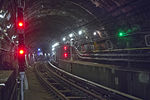The New York City Subway signaling system currently uses Automatic Block Signaling, with fixed wayside signals and automatic train stops. Many portions of the signaling system were installed between the 1930s and 1960s and most trains on the system are manually operated. Because of the age of the subway system, many replacement parts are unavailable from signaling suppliers and must be custom built for the New York City Transit Authority, which operates the subway. There are two different schemes of signaling in the system. The most used scheme is used on all B Division lines, originally built to the Brooklyn–Manhattan Transit Corporation (BMT) and Independent Subway System (IND)'s wider specifications, and on most of the A Division lines, built to the narrower specifications of the Interborough Rapid Transit Company (IRT). As part of the modernization of the New York City Subway, the MTA plans to upgrade much of the system with communications-based train control (CBTC) technology, which will control the speed, and starting and stopping, of subway trains. The CBTC system is mostly automated and uses a moving block system—which reduces headways between trains, increases train frequencies and capacities, and relays the trains' positions to a control room—rather than a fixed block system. The implementation of CBTC requires new rolling stock to be built for the subway routes using the technology, as only newer trains use CBTC.
Recently selected: King's Cross St Pancras tube station - International (Amtrak train) - Hunts Point Avenue station
